The History Of Oldsmobile

Oldsmobile was a brand of automobile produced for most of its existence by General Motors. Founded by Ransom E. Olds in 1897, the company still produces vehicles in the United States. In its 107-year history, it produced 35.2 million cars, including at least 14 million built at its Lansing, Michigan factory. When it was phased out, Oldsmobile was the oldest surviving American automobile marque, and one of the oldest in the world, after Daimler and Peugeot. It was GM's only brand to be phased out in the 2000s, since the phaseout of the Geo and Asuna (which was sold only in Canada) in the 1990s.
Early history
Oldsmobiles were first manufactured by the Olds Motor Vehicle Company in Lansing, Michigan, a company founded by Ransom E. Olds in 1897. In 1901, the company produced 425 cars, making it the first high-volume automobile manufacturer of the day. Olds became the top selling car company in the United States for a few years. Ransom Olds left the company in financial difficulties and formed the REO Motor Car Company. The last Curved Dash Olds was made in 1907. General Motors purchased the company in 1908.
The 1901 to 1904 Curved Dash was the first mass-produced car, made from the first automotive assembly line, an invention that is often miscredited to Henry Ford and the Ford Motor Company. After Olds sold the company in 1899, it was renamed Olds Motor Works and moved to a new plant in Detroit. By March 1901, the company had a whole line of models ready for mass production. Unfortunately, a mistake by a worker caused the factory to catch fire, and it burned to the ground, with all of the prototypes destroyed. The only car that survived the fire was a Curved Dash prototype, which was wheeled out of the factory by two workers while escaping the fire. A new factory was built, and production of the Curved Dash commenced.
Officially, the cars were called "Olds automobiles," colloquially referred to as "Oldsmobiles." It was this moniker, as applied especially to the Curved Dash Olds, that was popularized in the lyrics and title of the 1905 hit song "In My Merry Oldsmobile." From then on, the company and its products were known as Oldsmobile. Some two decades later, it was apparently the reputation of the vehicles that spawned a revival of the song for another round of popularity, essentially "returning the favor."
The 1910 Limited Touring was a high point for the company. Riding atop 42-inch wheels, and equipped with factory "white" tires, the Limited was the prestige model in Oldsmobile's two model lineup. The Limited retailed for US$4,600, an amount greater than the purchase of a new, no-frills three bedroom house. Buyers received goatskin upholstery, a 60hp (45kW) 707CID (11.6L) straight-6 engine, Bosch Magneto starter, running boards and room for five. Options included a speedometer, clock, and a full glass windshield. A limousine version was priced at $5,800. While Oldsmobile only sold 725 Limiteds in its three years of production, the car is best remembered for winning a race against the famed 20th Century Limited train, an event immortalized in the painting "Setting the Pace" by William Hardner Foster.
1930s
In the 1930s through the 1990s, Oldsmobile used a two digit model designation. As originally implemented, the first digit signified the body size while the second represents the number of cylinders. Body sizes were 6, 7, 8, and 9, and 6- and 8-cylinder engines were offered. Thus, Oldsmobiles were named 66 through 98.
In 1937, Oldsmobile was a pioneer in introducing a four-speed semi-automatic transmission called the "Automatic Safety Transmission", although this accessory was actually built by Buick, which would offer it in its own cars in 1938. This transmission featured a conventional clutch pedal, which the driver pressed before selecting either "low" or "high" range. In "low", the car shifted between first and second gears. In "high", the car shifted between first, third and fourth gears.
1940s
For the 1940 model, Oldsmobile was the first auto manufacturer to offer a fully automatic transmission, called the Hydramatic, which featured four forward speeds.
The last pre-war Oldsmobile rolled off the assembly line on February 5, 1942. During World War II, Oldsmobile produced numerous kinds of material for the war effort, including large-caliber guns and shells.
Production resumed on October 15, 1945 with a warmed-over 1942 model serving as the offering for 1946.
Oldsmobile once again was a pioneer when, for the 1949 model, they introduced their Rocket engine, which used an overhead valve V-8 design rather than the flathead "straight-8" design which prevailed at the time. This engine produced far more power than the engines that were popular during that era, and found favor with hot-rodders and stock car racers. The basic design, with few minor changes, endured until Oldsmobile redesigned their V8 engines in the mid '60's
1950s
Oldsmobile entered the 1950s following a divisional image campaign centered on its 'Rocket' engines and its cars' appearance followed suit. Oldsmobile's Rocket V8 engine was the leader in performance, generally considered the fastest cars on the market and by the mid 1950s their styling was among the first to offer a wide, "open maw" grille, suggestive of jet propulsion. Oldsmobile adopted a ringed-globe emblem to stress what marketers felt was its universal appeal. Throughout the 1950s, the make used twin jet pod-styled taillights as a nod to its "Rocket" theme. Oldsmobile was among the first of GM's divisions to receive a true hardtop in 1949, and it was also the among the first divisions (along with Buick and Cadillac) to receive a wraparound windshield, a trend that eventually all American makes would share at sometime between 1953 and 1964.
In the 1950s the nomenclature changed again, and trim levels also received names that were then mated with the model numbers. This resulted in the Oldsmobile 88 emerging as base Dynamic 88 and the highline Super 88. Other full-size model names included the "Holiday" used on hardtops, and "Fiesta" used on its station wagons. When the 88 was retired in 1999 (with a Fiftieth Anniversary Edition), its length of service was the longest of any model name used on American cars.
GM styling as a whole lost its frontrunner status in 1957 when Chrysler introduced Virgil Exner's "Forward Look" designs. When compared side to side, Oldsmobile looked dated next to its price-point competitor DeSoto. Compounding the problem for Oldsmobile and Buick was a styling mistake which GM called the "Strato Roof". Both makes had models which contained the heavily framed rear window, but Detroit had been working with large curved backlights for almost a decade. Consumers disliked the roof and its blind spots, forcing GM to rush a redesign into production on some of its models.
Oldsmobile's only off year in the 1950s was 1958. The nation was beginning to feel the results of its first significant post war recession, and US automobile sales were down for the model year. Oldsmobile, Buick and Cadillac received a heavy handed makeover of the 1957 GM designs. The Oldsmobile that emerged in 1958 bore little resemblance to the design of its forerunners; instead the car emerged as a large, over-decorated "chromemobile".
Up front, all 1958 Oldsmobiles received one of GM's heavily styled front fascias and quad-headlights. Streaking back from the edge of the headlights was a broad belt consisting of two strips of chrome on regular 88s, three strips on Super 88s, and three strips (top and bottom thin, inside thick) on 98s that ended in a point at mid-body. The bottom of the rear fender featured a thick stamping of a half tube that pointed forward, atop which was a chrome assembly of four horizontal chrome speed-lines that terminated into a vertical bar. The tail of the car featured massive vertical chrome taillight housings. Two chrome stars were fitted to the trunklid.
Ford styling consultant Alex Tremulis (designer of the 1948 Tucker Sedan) mocked the 1958 Oldsmobile by drawing cartoons of the car, and placing musical notes in the rear trim assembly. Another Detroit stylist employed by Ford bought a used 1958 Oldsmobile in the early 1960s, driving it daily to work. He detached and rearranged the OLDSMOBILE lettering above the grille to spell out SLOBMODEL as a reminder to himself and co-workers of what "bad" auto design meant to their business.
1960s
In the 1960s Oldsmobile's position between Pontiac and Buick in GM's hierarchy began to dissolve. Notable achievements included the introduction of the first turbocharged engine in 1962 (the Turbo Jetfire), the first modern front-wheel drive car produced in the United States (the 1966 Toronado), the Vista Cruiser station wagon (noted for its roof glass), and the upscale 442 muscle car. Olds briefly used the names Jetstar 88 (1964-1966) and Delmont 88 (1967-1968) on its least expensive full size models in the 1960s.
Notable models for the 1960s:
- Oldsmobile 442 - began as a 1964 muscle car option package (4-barrel carburetor, 4-speed manual transmission, 2 exhausts) on the F-85/ Cutlass. In 1965, to better compete with the Pontiac GTO, the original 330CID V8 rated at 310hp (231kW) was replaced by a new 400CID V8 rated at 345hp (257kW). The 442 definition was changed to "4" hundredCID V8 engine, "4"-barrel carburetor, and "2" exhaust pipes, and was named by "Car Craft Nationals" as the "Top Car of 1965." In 1968 the 442 became its own model and got a larger 455CID (7.5L) V8 engine in 1970.
- Oldsmobile Cutlass (1961 - 1999) - mid-size car. Oldsmobile's best seller in the 1970s and 1980s, and in some of those years America's best selling car. In 1966 a top-line Cutlass Supreme was introduced as a four-door hardtop sedan with a more powerful 320hp (239kW) 330CID Jetfire Rocket V8 than the regular F-85/ Cutlass models, a more luxurious interior and other trimmings. In 1967 the Cutlass Supreme was expanded to a full series also including two-door hardtop and pillared coupes, a convertible and a four-door pillared sedan. Also came with a 7.0L 425 CID engine as an option in 1966-1967
- Oldsmobile F-85 (1961-1972) - compact sedan, coupe and station wagon powered by a 215CID aluminum block V8 engine from 1961 to 1963. In 1964 the F-85 was upgraded to an intermediate sized car and the aluminum V8 was replaced by conventional cast iron six-cylinder and V8 engines. The Cutlass was initially the top model of the F-85 line but became a separate model by 1964 with the F-85 nameplate continued only on the lowest priced models through the 1972 model year, after which all Oldsmobile intermediates were Cutlasses.
- Oldsmobile Vista Cruiser (1964-1977) - a stretched wheelbase Cutlass station wagon, which was stretched to 120" from 115" in the 1964-67 models and to 121" from 116" in the 1968-72 models, the stretched area being in the second-row seating area. This car featured an elevated roof over the rear seat and cargo area and glass skylights over the rear seating area, which consisted of a transverse skylight over the second seat (two-piece from 1964-67, one-piece from 1968-72) and small longitudinal skylights directly over the rear cargo-area windows, and also featured standard second-row sunvisors. The three-seat models featured forward-facing seating, at a time when most three-seat station wagons had the third row of seats facing the rear. From 1965 - 1970, it would be Oldsmobile's flagship station wagon, as no full-sized wagons were produced. The third-generation 1973-77 models no longer had skylights other than an optional front-row pop-up sunroof. This car was merely an up-line trim package on the Cutlass Supreme wagon and carried the Vista Cruiser nameplate rather than the Cutlass nameplate. The optional third seat was rear-facing in the third-generation Vista Cruiser.
- Oldsmobile Starfire (1961-1966) - a sporty and luxurious hardtop coupe and convertible based on the 88. The Starfire featured interiors with leather bucket seats and a center console with floor shifter, along with a standard Hydra-Matic transmission, power steering and brakes (and power windows and seats on convertibles). It was powered by Oldsmobile's most powerful Rocket V8 engine, a 394CID engine from 1961 to 1964 rated from 330 to 345hp (257kW), and a larger 425CID Super Rocket V8 from 1965 to 1966, rated at 375hp (280kW).
- Oldsmobile Jetstar I (1964-1966) - Life for the somewhat obscure Jetstar I started in 1964. It was designed to be a low cost option to the successful full size Starfire series - more of a direct competitor to the Pontiac Grand Prix. Standard equipment included the 345hp (257kW) 394ci Starfire engine, vinyl bucket seats and console. Keeping the “sport” part of the Starfire, it possessed less of the luxury and glitz. It weighed in at 4028 pounds, and 16,084 were produced for 1964. It was a Starfire without the frills and was informally dubbed “the poor man’s Starfire”. Proving to be an ill-fated model, 1965 concluded the 2 year run for the Jetstar I. Only 6,552 were sold. The introduction of the Pontiac GTO and Olds 4-4-2 in 1964 insured the future of the musclecars were the intermediates, and the front-drive Toronado loomed big in Oldsmobile's future taking over the flagship status from the Starfire. Further confused with its less brethren with the Jetstar 88 nameplate, there was no way but out for the Jetstar I. And close examination of prices revealed that unless one bought a sparsely optioned JS1, there was little financial incentive to buy a JS1 over the Starfire. Take the $3602 base price and add the $107.50 power steering, the $43.00 power brakes, and the $242.10 automatic transmission (all standard on the Starfire), and you had a $4,000 Jetstar I. And less than $150 more would buy you the $4148 based priced Starfire, which not only included those standard features but a more luxurious leather interior. But lost the mix was a jewel of a high performance car in the ’65 Jetstar I. Trimmed down to 3963#, the ’65 model was an overlooked performance car. The new 370hp (276kW) 425ci Starfire engine delivered 470lb·ft (637N·m) of torque, was durable, and was quite an improvement over the ’64 394. How serious was that horsepower and torque in ’65? If you wanted this much power in a Pontiac, it was only available in the top-of-the-line 421 HO Tri-Power engine that was not standard in any Pontiac model, but an extra-cost option. The new Oldsmobile Turbo Hydra-Matic transmission was a vast performance improvement over the previous “slim-jim” Hydra-Matic transmission. But best of all, Olds offered the Muncie 4-speed with Hurst shifter in ’65. Oldsmobile boasted in a 1965 press release that “a Jetstar I proved to be the top accelerator of the entire event” at the 1965 Pure Oil Performance Trials in Daytona beach. Those trials were sanctioned and supervised by NASCAR.
Note: between 1964 and 1966, Oldsmobile named its least expensive full size model the Oldsmobile Jetstar 88 which the Jetstar I was not related to, and priced $500-$600 below the Jetstar I.
- Oldsmobile Toronado (1966-1992) - a front-wheel drive coupe in the personal luxury car category, introduced in 1966. At the time, the largest and most powerful front wheel drive car ever produced, and one of the first modern front wheel drive cars equipped with an automatic transmission. The original Toronado was powered by a 425CID Super Rocket V8 engine rated at 385hp (287kW), mated to a three speed Turbo Hydra-Matic transmission. The Toronado was Motor Trend magazine's 1966 "Car of the Year."
1970s-1980s
Oldsmobile sales soared in the 1970s and 1980s (for an all-time high of 1,066,122 in 1985) based on popular designs, positive reviews from critics and the perceived quality and reliability of the Rocket V8 engine, with the Cutlass series becoming the North America's top selling car by 1976. By this time, Olds had displaced Pontiac and Plymouth as the #3 best selling brand in the U.S. behind Chevrolet and Ford. In the early 1980s, model-year production topped one million units on several occasions, something only Chevrolet and Ford had achieved.
The soaring popularity of Oldsmobile vehicles resulted in a major issue in the late 1970s. At that time, each General Motors division produced its own V-8 engines, and in 1977, Oldsmobile, Chevrolet, Pontiac and Buick each produced a unique 350 cubic inch displacement V-8.
It was during the 1977 model year that demand exceeded production capacity for the Oldsmobile V-8, and as a result Oldsmobile quietly began equipping some full size Delta 88 models and the very popular Cutlass/ Cutlass Supreme with the Chevrolet 350 engine instead. Although it was widely debated whether there was a difference in quality or performance between the two engines, there was no question that the engines were different from one another. Many customers were loyal Oldsmobile buyers who specifically wanted the Rocket V-8, and did not discover that their vehicle had the Chevrolet engine until they performed maintenance and discovered that purchased parts did not fit. This became a public relations nightmare for GM.
Following this debacle, disclaimers stating that "Oldsmobiles are equipped with engines produced by various GM divisions" were tacked on to advertisements and sales literature; all other GM divisions followed suit. In addition, GM quickly stopped associating engines with particular divisions, and to this day all GM engines are produced by "GM Powertrain" (GMPT) and are called GM "Corporate" engines instead of GM "Division" engines. Although it was the popularity of the Oldsmobile division vehicles that prompted this change, declining sales of V-8 engines would have made this change inevitable as all but the Chevrolet (and, later, Cadillac's Northstar) versions were eventually dropped.
Notable models:
- Oldsmobile Cutlass Supreme (1967-1997) - more performance and luxury than the lower priced Cutlass and Cutlass S models, fitting in at the lower end of the personal luxury car market. Models were similar to the Pontiac Grand Prix, Chevrolet Monte Carlo, and Buick Regal.
- Oldsmobile 98 - Oldsmobile full-sized luxury sedan that was downsized in 1977 and 1985, became front wheel drive in 1985
- Oldsmobile Toronado (1966-1992) - personal luxury coupe, major redesign downsized the car in 1986, Motor Trend Car of the Year in '66
- Oldsmobile Omega (1973-1984) - compact car based on the Chevrolet Nova and later the Chevrolet Citation.
- Oldsmobile Calais (or Cutlass Calais) (1985-1991) - popular compact coupe or sedan on GM's "N-body" platform, similar to the Pontiac Grand Am. The series' name was taken from what was formerly the high-end option package for Cutlass Supreme models.
- Oldsmobile Cutlass Ciera (1982-1996) - popular selling upscale mid-sized car based on GM's A platform.
- Oldsmobile Custom Cruiser (1971-1992) - full-size station wagon.
- Oldsmobile Starfire (1975-1981) - sporty compact car similar to the Chevrolet Monza, which was itself a spinoff of the Chevrolet Vega.
- Oldsmobile Firenza (1982-1988) - compact sedan, hatchback, coupe, and station wagon based on GM's J-body, sharing the same bodyshell with the Chevrolet Cavalier, Pontiac Sunbird, Buick Skyhawk and the Cadillac Cimarron.
1990s
After the tremendous success of the early 1980s, things changed quickly for Oldsmobile, and by 1990 the brand had lost its place in the market, squeezed between the resurgent Pontiac and Buick divisions. Oldsmobile's signature cars gave way to rebadged models of other GM cars, and GM shifted the performance mantle to Chevrolet and Pontiac. GM continued to use Oldsmobile sporadically to showcase futuristic designs and as a "guinea pig" for testing new technology, with Oldsmobile offering the Toronado Trofeo, which included a visual instrument system with a calendar, datebook, and climate controls. For 1995, Oldsmobile introduced the Aurora, which would be the inspiration for the design of its cars from the mid-1990s onward. The introduction of the Aurora marked as GM's catalyst to reposition Oldsmobile as an upscale import fighter. Accordingly, Oldsmobile received a new logo based on the familiar "rocket" theme. Nearly all the existing model names were gradually phased out: the Cutlass Calais in 1991, the Toronado and Custom Cruiser in 1992, the Ninety-Eight and Ciera (formerly Cutlass Ciera) in 1996, Cutlass Supreme in 1997, and finally the Eighty-Eight and Cutlass (which had only been around since '97) in 1999. They were replaced with newer, more modern models with designs inspired by the Aurora.
Redesigned & new models introduced from 1990–2004:
- Oldsmobile Achieva (1992-1998) - compact sedan & coupe
- Oldsmobile Alero (1999-2004) - compact sport sedan & coupe
- Oldsmobile Aurora (1995-2003) - full-size luxury/ performance sedan (redesigned for 2001)
- Oldsmobile Bravada (1991-2004) - mid-size premium SUV (redesigned for 1996 and 2002)
- Oldsmobile Cutlass (1997-1999) - mid-size sedan
- Oldsmobile Eighty Eight (1949-1999) - full-size premium sedan (redesigned for 1992)
- Oldsmobile Intrigue (1998-2002) - mid-size luxury/ sport sedan
- Oldsmobile Ninety-Eight (1941-1996) - full-size luxury sedan (redesigned for 1991)
- Oldsmobile Silhouette (1990-2004) - premium minivan (redesigned for 1997)
2000s
In spite of Oldsmobile's critical successes since the mid-1990s, a reported shortfall in sales and overall profitability prompted General Motors to announce in December 2000 their plans to phase out the Oldsmobile brand. The announcement took place just two days after Oldsmobile unveiled what would be its last new model ever, the Bravada SUV - which became, somewhat ironically, another critical hit for the division.
The phaseout was conducted on the following schedule:
- Mid-2001: The 2002 Bravada, the company's last new model, hits Oldsmobile showrooms
- June 2002: Production ends for Intrigue and the Aurora V6 sedans
- May 2003: Aurora V8 sedan production ends
- January 2004: Bravada SUV production ends
- March 2004: Silhouette minivan production ends
- April 2004: Alero compact car production ends
The final 500 Aleros, Auroras, Bravadas and Intrigues produced received special Oldsmobile heritage emblems and markings which signified 'Final 500'. All featured a unique Dark Cherry Metallic paint scheme. Auroras and Intrigues would be accompanied by special Final 500 literature.
The final production day for Oldsmobile was April 29, 2004. The division's last car built was an Alero GLS 4-door sedan, which was signed by all of the Olds assembly line workers. It is on display at the R.E. Olds Transportation Museum located in Lansing, Michigan.
- Oldsmobile Curved Dash (1901-1907)
- Oldsmobile Limited Touring
- Oldsmobile 40
- Oldsmobile 53
- Oldsmobile 66 (1940s)
- Oldsmobile 88 (1949-1999)
- Oldsmobile 98 (1941-1996)
- Oldsmobile Series 60 (1939-1948)
- Oldsmobile Series 70 (1946-1950)
- Oldsmobile Series 90 (1941-1996)
- Oldsmobile 442 (1968-1971)
- Oldsmobile Cutlass (1964-1999)
- Oldsmobile Cutlass Supreme (1970-1997)
- Oldsmobile Cutlass Salon
- Oldsmobile Cutlass Calais (1985-1991)
- Oldsmobile Cutlass Ciera (1982-1996)
- Oldsmobile Custom Cruiser (1971-1992)
- Oldsmobile Vista Cruiser (1964-1977)
- Oldsmobile F-85 (1961-1963)
- Oldsmobile Toronado (1966-1992)
- Oldsmobile Starfire (1975-1980)
- Oldsmobile Firenza (1982-1988)
- Oldsmobile Aerotech(1987-1992)
- Oldsmobile Achieva (1992-1998)
- Oldsmobile Alero (1999-2004)
- Oldsmobile Aurora (1995-2003)
- Oldsmobile Bravada (1991-2004)
- Oldsmobile Intrigue (1998-2002)
- Oldsmobile Silhouette (1990-2004)
The Oldsmobile is notable for having inspired numerous popular songs:
- "In My Merry Oldsmobile", a 1905 song with music by Gus Edwards and lyrics by Vincent P. Bryan; the song enjoyed a second round of popularity in the 1920s. This music is available in a short cartoon (1932) with same name by Fleischer Studios.
- "Rocket 88", a 1951 song by Ike Turner said by many to be the first rock and roll record.
- In the 1974 Tom Waits song "The Heart of Saturday Night," the subject of the song drives an Oldsmobile.
- In Tom Waits 1992 song "goin' out west" a "olds 88" is mentioned as the protagonist's car.
- "You're Gonna Get Yours" from Public Enemy's 1987 debut album Yo! Bum Rush The Show, an ode to the Ninety-Eight.
- "This Is Your Daddy's Oldsmobile," a 1990 song by Ray Stevens.
- "455 Rocket", a 1997 song by Kathy Mattea.
- Elliott Smith's song "Condor Ave." from album Roman Candle begins with the line, "She took the Oldsmobile out past condor avenue."
- A line in the Wreckers song "My, Oh My" goes, "This parking lot used to be a field, I parked here in my Oldsmobile."
Oldsmobile cars can also been seen in several popular movies and television series:
- Oldsmobile was a sponsor of the TV version of Michael Shayne (NBC, 1960-1961). Therefore most of the cars in the show were Oldsmobiles, including the police cars and taxis. As the title character, actor Richard Denning drove a 1960 Olds 98 convertible.
- The Enforcer (1976) - When Clint Eastwood And John Mitchum appears in this film, driving A light red orange metallic 1973 Oldsmobile Delta 88 Royale Brougham 2-door coupe.
- The Gauntlet (1977 film) (1977) - Clint Eastwood stars as Ben Shockley, Sondra Locke stars as Gus Mally, Bill McKinney stars as Constable And Al Silvani stars as Police Sergeant that destroys the interior of A light blue 1975 Oldsmobile Custom Cruiser Brougham 4-door station wagon.
- Every Which Way But Loose (1978) - When Clint Eastwood, Sondra Locke, Roy Jenson And Al Silvani appears in this film, driving A champagne gold 1970 Oldsmobile Cutlass Supreme Brougham 2-door coupe.
- Escape From Alcatraz (1979) - Clint Eastwood stars as Frank Morris, Fred Ward stars as John Anglin, Ross Reynolds stars as Helicopter Pilot And Eugene Jackson stars as 7th Inmate that destroys the interior of A champagne metallic 1975 Oldsmobile Toronado GT 2-door coupe. Betty Field stars as Stella Johnson.
- Sgt. Pepper's Lonely Hearts Club Band (1978): A stretch Toronado Limo is used.
- The Blues Brothers (1980) - During the famous chase scene inside the Dixie Square Mall, the Blues Brothers skid through the windows of an Oldsmobile showroom filled with 1980 models. As they pull away, Elwood remarks, "New Oldsmobiles are in early this year."
- Actor Bruce Dern drove an Olds 98 4-door sedan in the movie Middle Age Crazy (1980). The car is mentioned in the movie's title song.
- Any Which Way You Can (1980) - When Clint Eastwood arrives in Jackson Hole, Wyoming, for the big fight, his opponent and friend William Smith is driving a brand-new, red 1980 98 Regency sedan which is featured prominently in the end of the film.
- Bronco Billy (1980) - When Clint Eastwood And Sondra Locke arrives in Los Angeles, California, driving A satin silver metallic 1980 Oldsmobile Custom Cruiser Brougham 4-door station wagon. The grille was misspelled "Oldsmobile" to spell out SLOB MODEL. Actor Betty Field appears in this film.
- Honkytonk Man (1981) - When Clint Eastwood And Roy Jenson arrives in Memphis, Tennessee, driving A navy blue 1980 Oldsmobile Toronado Brougham 2-door coupe.
- Firefox (1982) - When Clint Eastwood And Warren Clarke arrives in Baghdad, Syria, driving A light blue 1977 Oldsmobile 98 Regency 2-door coupe.
- Director Sam Raimi features a yellow 1973 Oldsmobile Delta 88 in many of his films, particularly the Evil Dead films where it is driven by main character Ash. In Raimi's Spider-Man, the car is driven by Uncle Ben. This vehicle was personally owned by Raimi.
- A Christmas Story (1983) - Ralphie says, "Some men are Baptists, others Catholics, my father was an Oldsmobile man."
- Sudden Impact (1983) - Clint Eastwood's co-star and real life girlfriend Sondra Locke squeals the front tires while driving away in a then-new Olds Firenza hatchback.
- City Heat (1984) - When Clint Eastwood And Burt Reynolds appears in his film, driving A satin silver metallic 1982 Oldsmobile 98 Regency 2-door coupe.
- Tightrope (film) (1984) - When Clint Eastwood, Dan Hedaya, Jamie Rose And Genevieve Bujold appears in this film, driving A black cherry 1982 Oldsmobile Delta 88 Royale Brougham 4-door sedan.
- Heartbreak Ridge (1986) - When Clint Eastwood And Eileen Heckart appears in this film, driving A dark maple red metallic 1979 Oldsmobile Toronado Brougham 2-door coupe.
- Bird (1988 film) (1987) - When Clint Eastwood And Betty Field appears in this film, driving A bright red 1977 Oldsmobile Cutlass Supreme Brougham 4-door sedan.
- Lethal Weapon (1987) - Murtaugh (Danny Glover) drives a 1986 Oldsmobile Delta 88. 1985 Oldsmobile 98 Regency is seen as the villain's vehicle.
- The Dead Pool (1988) - Clint Eastwood's character, Harry "Dirty Harry" Callahan, is pursued by a remote controlled bomb disguised as a radio controlled car through hilly San Francisco in a 1985 Oldsmobile 98 Regency .
- Lethal Weapon 2 (1989) - Murtaugh is driving his wife's brand new Custom Cruiser station wagon, which is slowly and methodically destroyed throughout the movie. Later in the film, he drives a 1989 88. A 1989 Cutlass Ciera coupe is one of the vehicles driven by the villans in the chase seen.
- Pink Cadillac (1989) - When Clint Eastwood And Geoffrey Lewis appears in this film, driving An autumn maple red metallic 1982 Oldsmobile Cutlass Ciera Brougham 2-door coupe.
- Turner and Hooch (1989) stars Tom Hanks as a police officer who is in charge of a dog that destroys the interior of his 1989 Oldsmobile 88 Royale Brougham.
- King of New York (1990) - A 1978-80 Ninety Eight Regency is used as an undercover vehicle by crooked NYPD narcotics where they pursue Frank White (Christopher Walken) in a mid-1980s Cadillac Fleetwood limousine. The Ninety Eight was totalled.
- The Dark Half (1993) - The villain, George Stark (played by Timothy Hutton), is seen driving a jet-black 1966 Toronado in several scenes.
- Demolition Man (1993) - Set mostly in the year 2032, a bright red 1970 Olds 442 is discovered by police officers John Spartan (played by Sylvester Stallone), Lenina Huxley (played by Sandra Bullock) and Alfredo Garcia (played by Benjamin Bratt) in the slums beneath San Angeles. Using an old elevator, the car bursts up through the floor of a modern-day Oldsmobile dealer, and Stallone's character drives it out of the showroom onto the street, beginning an extensive car chase scene. Many other GM cars and concept vehicles were used in the film including the GM Ultralite, which was featured prominently. Ironically, since Oldsmobile folded in 2004, the Oldsmobile dealer set in the year 2032 is now an anachronism. The dealer was also still using the early-90s version of the Oldsmobile logo, which was replaced only 3 years after the release of the film.
- Get Shorty (1995) - John Travolta's character is incredulous at being given an Oldsmobile Silhouette minivan for a rental instead of his requested Cadillac, to which the rental clerk responds, "You got the Cadillac of minivans," a line oft-repeated outside of the movie.
- Fargo (1996) - late 1980s Oldsmobile cars including the Cutlass Ciera and Ninety-Eight Regency Brougham were featured, as William H. Macy's character was general manager of his father-in-law's Oldsmobile dealership.
- The X-Files (1998) - an Oldsmobile Intrigue was heavily used by the characters as part of a promotional tie-in between General Motors and the movie's producers. Earlier on in the series, Oldsmobile Cutlass Cieras were featured.
- That 70's Show (1998-2006) features a 1969 Oldsmobile Vista Cruiser driven by lead character Eric Forman, and many scenes take place in or around "the Vista Cruiser".
- Reindeer Games (2000) - a 1989 or 1990 Cutlass Ciera sedan is used as a getaway vehicle.
- An Oldsmobile 88 is featured on the cover art and opening sequence of the video game Driver 2.
- Spiderman (2002) - Uncle Ben owned an Oldsmobile 88 and tells his nephew Peter Parker in the car With great power comes great responsibility. He was eventually carjacked and killed.
- Barbershop (2002) The character played by Ice Cube drives a maroon 1987 Cutlass Ciera and tries, unsuccessfully, to sell it at a used car lot in a desperate attempt to get cash to pay off a debt.
- 8 mile (2002) - Eminem "B-Rabbit" and his friends were riding around in a worn-out Oldsmobile 98. They shoot a paintball gun at a police car, and the police give chase. During the chase, the electrical system shorts out, and the car shuts down, forcing them to evade the police by coasting into an alley.
- Cheaper By The Dozen (2003) - Tom Baker (Steve Martin) gives his son Charlie (Tom Welling) a well-worn early 1980s Olds Cutlass Supreme.
- Memphis Bleek (2003) - 'Round Here' music video produced by Def Jam.
- The Matrix Reloaded (2003) - many Oldsmobiles are used as cameo vehicles, especially during the famous highway chase scene. Even though the characters never drive an Oldsmobile in the film, there was interaction between Oldsmobiles in the scene. There is one part when Agent Johnson jumps on top of the front of an Aurora, completely destroying the front end and causing the car to do a front flip and land on its roof. Another scene involves the Twins gunning down an Intrigue and shoving it into the divider wall, causing it to do a barrel roll and land on its roof.
- Common (2005) - The Corner (song) music video features a blue 1980s Oldsmobile 88. He even raps "So we can cop clothes & roll in a Rolls / Now I roll in a Olds with windows that don't roll."
- Cars (2006): Piston Cup Championship Sportscaster Bob Cutlass, voiced by Bob Costas, is a 1999 Aurora.
- Tenacious D in the Pick of Destiny (2006): A Blue 1987 Cutlass Supreme sedan is used in the Car chase scene, and is also referenced in one of the songs during the movie.
- Dead Silence (2007): The Main Character drives a 1970 442 Cutlass Supreme Convertible. In which a chase scene with the ghost happens in it.
- Four Brothers (2006): Mark Wahlberg's character drives a 1986 442 Cutlass Supreme, in which is destroyed during a high speed chase after two hired killers.
Personal Luxury And Full-Size
Early on in their history, Olds enjoyed a healthy public relations boost from the 1905 hit song " In My Merry Oldsmobile". The well known song was updated in the fifties to sing about "The Rocket 88".
The strong public relations efforts by GM in the 1950s was epitomized in the Motorama auto show. The impact of that traveling show, was literally a "one company", auto-show extravaganza. Millions of Americans attended, in a spirit not unlike a "mini-World's Fair". Every GM division had a "Dream Car". Oldsmobile's dream/ concept car was called "The Golden Rocket".
The Dr. Oldsmobile theme was one of Oldsmobile's most successful marketing campaign's in the early '70s, it involved fictional characters created to promote the wildly popular 442 muscle car. 'Dr. Oldsmobile' was a tall lean professor type who wore a white lab coat. His assistants included 'Elephant Engine Ernie' who represented the big block 455 Rocket engine. 'Shifty Sidney' was a character who could be seen swiftly shifting his hand using a Hurst shifter. 'Wind Tunnel Waldo' had slicked back hair that appeared to be constantly wind blown. He represented Oldsmobile's wind tunnel testing, that produced some of the sleekest designs of the day. Another character included 'Hy Spy' who had his ear to the ground as he checked out the competition.
In the 1970s, the mid-size Oldsmobile Cutlass was the division's best-selling model, and for several years in the late 1970s and early 1980s, it was the best-selling car in America. But the sales of the Cutlass and other Oldsmobile models fell beginning in the 1990s. The brand was hurt by its image as old and stuffy, and this perception continued despite a public relations campaign in the late 1980s that proclaimed this was "not your father's Oldsmobile." Ironically, many fans of the brand say that the declining sales were in fact caused by the "this is not your father's Oldsmobile" campaign", as the largest market for Oldsmobiles was the population whose parents had in fact owned Oldsmobiles.
- Kimes, Beverly R., Editor. Clark, Henry A. (1996). The Standard Catalog of American Cars 1805-1945. Kraus Publications. ISBN 0-87341-428-4.
- Gunnell, John, Editor (1987). The Standard Catalog of American Cars 1946-1975. Kraus Publications. ISBN 0-87341-096-3.
- 1957-58 Oldsmobile: From Beautiful to Baroque. John Lawler, author. Collectible Automobile Magazine. February, 1994, pp.22-37.
- Oldsmobile Prepares For The End, published in June 2003
- Dead at 106: Oldsmobile, published in April 2004
From Wikipedia, the free encyclopedia
More About Oldsmobile

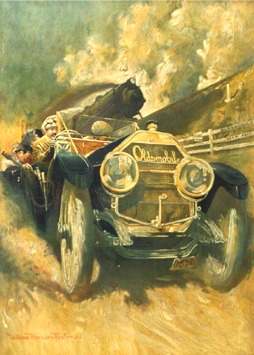

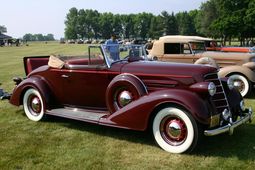

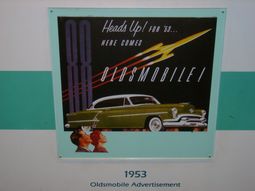


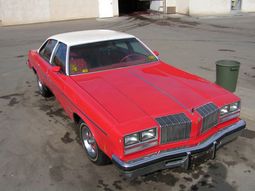
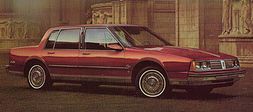

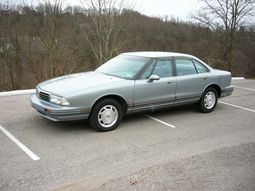
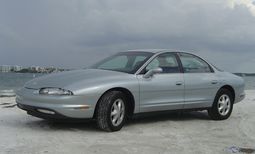
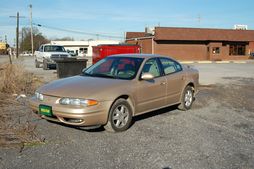
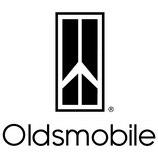
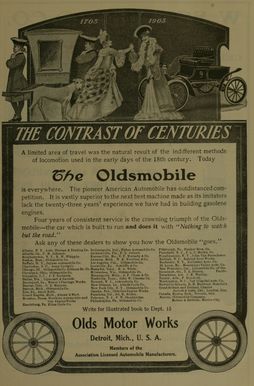
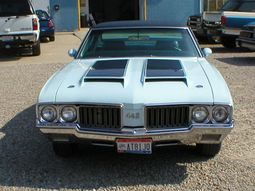
|